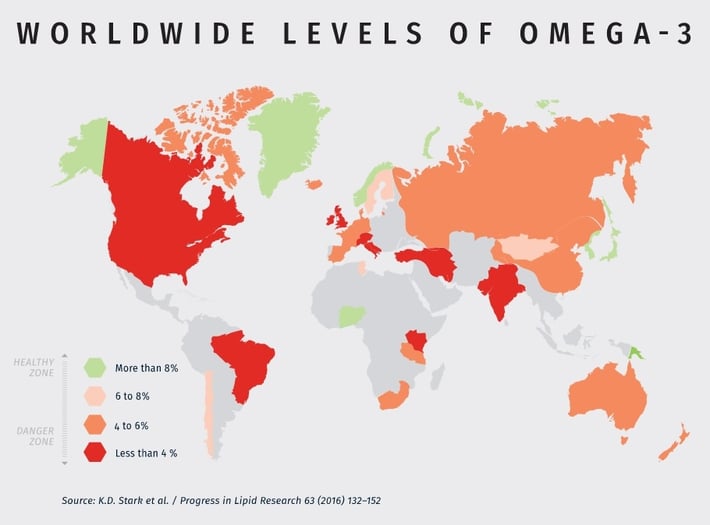OMEGA-3 INDEX
Window into your state of health
Much of the world’s population exhibits low levels of the omega-3s EPA and DHA, according to a study published in the May 2016 issue of Progress in Lipid Research. The study’s mapping of countries and regions raises growing concern that low omega-3 status has become a global public health concern, as omega-3 deficiency is associated with several chronic disorders.
As the index below illustrates, high scores on the Omega-3 Index scale are better for your health. 8 percent and above are considered the desired level, whereas 4 percent or lower is associated with health related problems. The map shows that low levels of omega-3s are common in much of the world.

Alarmingly low Omega-3 levels
The map shows the average Omega-3 (EPA+DHA) levels in the blood cells of the population, according to a recently published study (Stark et al., 2016).
“A low Omega-3 Index correlates with a higher risk of cardiac death, while a high O3i is ideal for maintaining a healthy heart,” explains Dr. Bill Harris, an internationally recognized omega-3 expert and co-inventor of the Omega-3 Index Test. “Unfortunately, most people globally have a low or very low Omega-3 Index, which significantly increases their risk of cardiac death.”
To address this global health issue, we at Aker BioMarine established the Omega-3 Index Project (O3i) with several industry partners, associations, and nonprofits to raise awareness of the risks associated with low omega-3 levels.
Measuring omega-3 levels regularly using the Omega-3 Index test will help consumers and patients to identify, correct and maintain healthy levels of these important nutrients and reduce their risk of chronic disease.
Improving
human health
Krill oil has many health benefit applications due to its unique, natural composition of omega-3s EPA and DHA, phospholipids and choline.